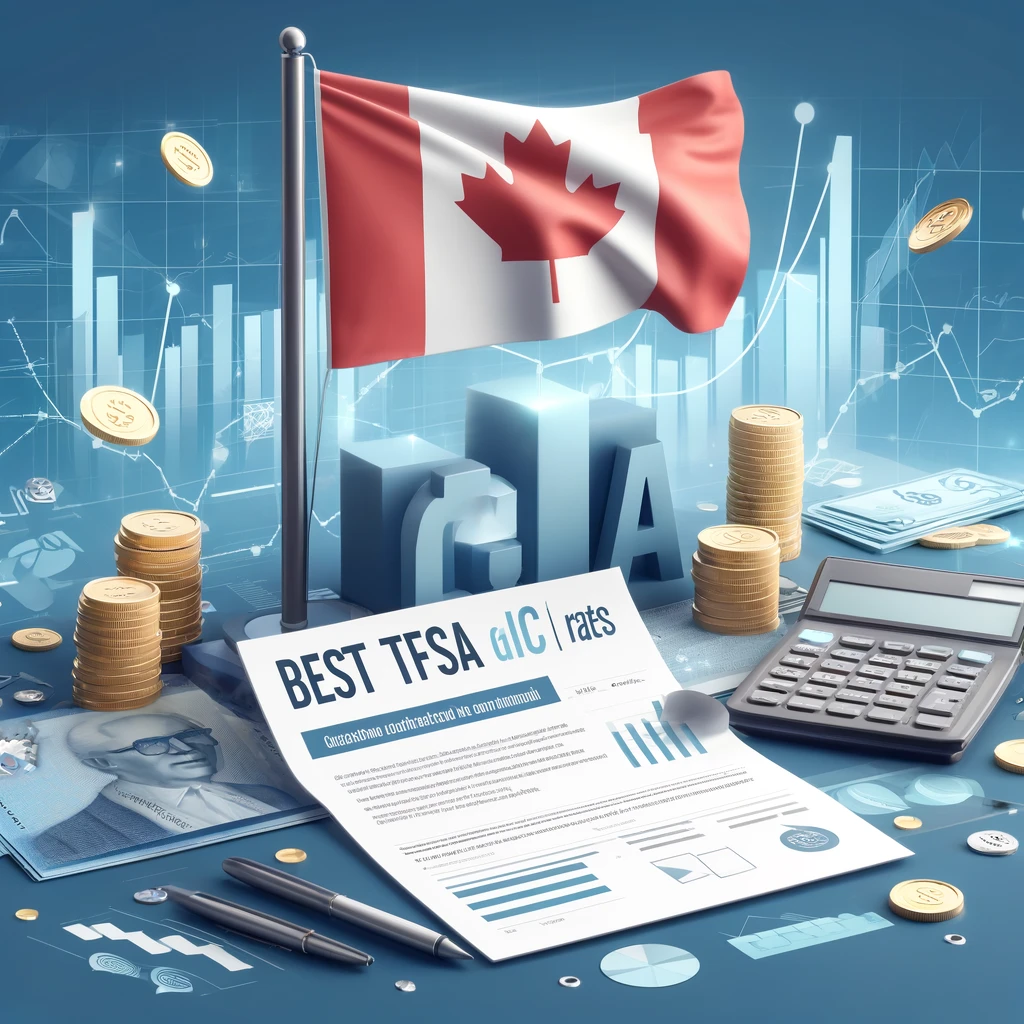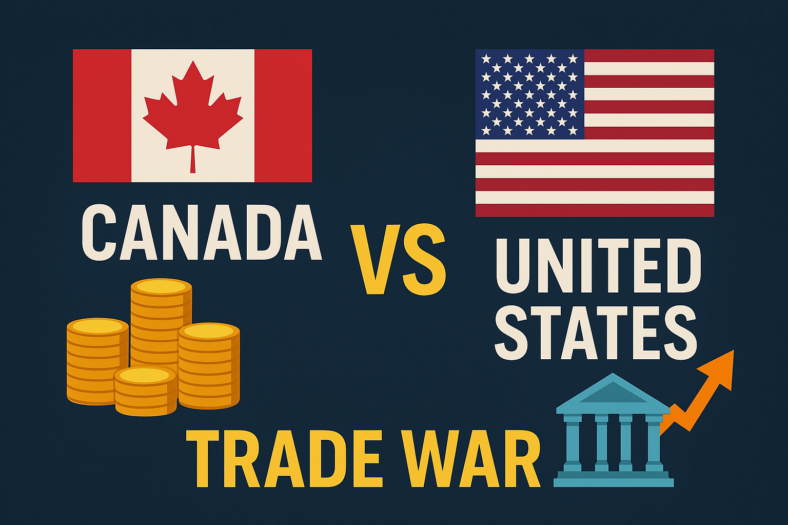In the realm of personal finance, maximizing returns while minimizing risk is a common goal. For Canadians, the Tax-Free Savings Account (TFSA) offers an excellent vehicle for achieving this balance. Since its introduction in 2009, the TFSA has become a staple for savvy savers, providing a flexible and tax-advantaged way to grow wealth. Within a TFSA, one of the most secure and predictable investment options is the Guaranteed Investment Certificate (GIC). This guide is designed to help you navigate the landscape of the best TFSA GIC rates in Canada, ensuring that you can make informed decisions to maximize your savings potential.
A TFSA allows you to earn tax-free investment income, which means the returns on your investments within the account are not subject to Canadian income tax. This makes TFSAs an attractive option for both short-term savings and long-term investment goals. A GIC, on the other hand, is a type of investment that offers a guaranteed rate of return over a specified period, making it an ideal choice for conservative investors seeking low-risk, predictable returns.
Choosing the best GIC rates is crucial for maximizing your investment returns, as even small differences in interest rates can significantly impact your savings over time. This guide will provide an in-depth look at the top TFSA GIC rates available in Canada, helping you to compare options and select the best fit for your financial goals. Whether you’re new to investing or looking to optimize your current portfolio, understanding the nuances of TFSA GICs will empower you to make the most of your tax-free savings opportunities.
Best TFSA GIC Rates in Canada – Our Top Picks
What are TFSA GICs?
TFSA GICs are a combination of two powerful financial tools available to Canadians: the Tax-Free Savings Account (TFSA) and Guaranteed Investment Certificates (GICs). Understanding these concepts individually and how they work together is crucial for making the most of your savings and investments.
Tax-Free Savings Account (TFSA)
A TFSA is a registered account introduced by the Canadian government in 2009 to encourage personal savings. Contributions to a TFSA are made with after-tax dollars, but the investment income earned within the account—whether interest, dividends, or capital gains—is not subject to tax. This tax-free growth makes TFSAs an attractive option for saving for a variety of financial goals, from short-term needs to long-term retirement planning.
Key Features of TFSAs:
- Contribution Limits: Annual contribution limits are set by the government and can carry forward if not used. For example, if you do not use your contribution room in one year, it will be added to the next year’s limit.
- Withdrawals: Funds can be withdrawn at any time without tax penalties. The withdrawn amount is added back to your contribution room in the following year.
- Flexibility: TFSAs can hold a variety of investments, including cash, stocks, bonds, mutual funds, and GICs.
Guaranteed Investment Certificates (GICs)
A GIC is a low-risk investment product offered by Canadian financial institutions. When you purchase a GIC, you agree to lend money to the bank for a specified term, ranging from a few months to several years, in exchange for a guaranteed interest rate.
Key Features of GICs:
- Guaranteed Returns: The principal amount and interest rate are guaranteed, making GICs one of the safest investment options.
- Fixed Terms: GICs have fixed terms, and the interest rate is typically higher for longer terms.
- Types of GICs: There are various types, including redeemable (cashable) GICs, non-redeemable GICs, and market-linked GICs. Each type has different conditions regarding access to funds and interest rate calculations.
Combining TFSAs and GICs
When you hold a GIC within a TFSA, you combine the benefits of both investment tools. This arrangement is often referred to as a TFSA GIC.
Benefits of TFSA GICs:
- Tax-Free Interest: The interest earned on the GIC within the TFSA is tax-free, maximizing your returns.
- Security: GICs provide a guaranteed return on your investment, offering peace of mind and capital preservation.
- Flexibility: Depending on the type of GIC, you may have the flexibility to access your funds before the maturity date, though this can affect the interest rate.
Considerations for TFSA GICs:
- Contribution Limits: Ensure that your total TFSA contributions, including GIC investments, do not exceed your available contribution room to avoid penalties.
- Term Length and Liquidity Needs: Choose GIC terms that align with your financial goals and liquidity needs. While longer terms offer higher rates, they also tie up your funds for extended periods.
- Interest Rates: Shop around for the best GIC rates from different financial institutions to maximize your returns.
By investing in GICs within a TFSA, you can achieve a balance of safety, predictability, and tax efficiency. This combination is particularly appealing for conservative investors or those looking to preserve capital while still earning a competitive return
Pros and cons of TFSA GICs
Pros of TFSA GICs
Tax-Free Growth:
- Pro: One of the most significant advantages of holding GICs within a TFSA is that the interest earned is completely tax-free. This means you don’t have to pay any taxes on the returns, allowing your investment to grow more quickly compared to taxable accounts.
Guaranteed Returns:
- Pro: GICs provide a guaranteed rate of return. Unlike stocks or mutual funds, where the value can fluctuate, GICs ensure that you will receive a fixed amount of interest over the term, providing peace of mind and predictability.
Capital Preservation:
- Pro: GICs are one of the safest investment options available. Your principal investment is protected, meaning you will not lose your initial deposit, making it ideal for conservative investors or those nearing retirement who want to preserve their capital.
Flexible Terms:
- Pro: GICs come with a variety of term lengths, ranging from a few months to several years. This allows you to choose a term that matches your financial goals and liquidity needs.
No Withdrawal Penalties:
- Pro: With a TFSA, you can withdraw funds at any time without tax penalties. While this is generally true for all TFSA investments, it’s particularly beneficial for redeemable GICs that allow early access to your money.
Contribution Room Reinstatement:
- Pro: When you withdraw funds from your TFSA, the amount withdrawn is added back to your contribution room in the following year, maintaining your ability to maximize tax-free savings in the future.
Cons of TFSA GICs
Limited Growth Potential:
- Con: While GICs offer guaranteed returns, these returns are generally lower than what you might achieve with riskier investments like stocks or mutual funds. This can limit the overall growth potential of your TFSA.
Liquidity Constraints:
- Con: Non-redeemable GICs lock in your funds for the entire term. If you need to access your money before the maturity date, you might face penalties or be unable to withdraw the funds, which can be a drawback if unexpected expenses arise.
Inflation Risk:
- Con: The fixed interest rates on GICs may not keep pace with inflation over time, potentially eroding the purchasing power of your returns. This is particularly relevant for long-term GICs.
Contribution Limits:
- Con: TFSAs have annual contribution limits. Over-contributing to your TFSA can result in penalties from the Canada Revenue Agency (CRA). It’s essential to track your contributions carefully to avoid exceeding your limit.
Interest Rate Fluctuations:
- Con: GIC rates are influenced by prevailing market interest rates. If you lock in a GIC during a period of low interest rates, you might miss out on higher returns if rates increase shortly after your purchase.
Opportunity Cost:
- Con: By locking your funds in a GIC, you might miss out on potentially higher returns from other investments. This opportunity cost can be a significant factor if market conditions are favorable for higher-risk investments.
TFSA GICs offer a blend of safety, tax advantages, and guaranteed returns, making them an attractive option for conservative investors or those looking to preserve capital. However, they also come with limitations, such as lower growth potential and liquidity constraints. By carefully considering these pros and cons, you can determine whether TFSA GICs align with your financial goals and risk tolerance, ensuring that you make the most of your tax-free savings opportunities.
What types of TFSA GICs are available in Canada?
In Canada, Guaranteed Investment Certificates (GICs) within a Tax-Free Savings Account (TFSA) come in various forms to suit different investment needs and preferences. Each type of TFSA GIC has its own features, benefits, and limitations. Understanding these options will help you choose the best one for your financial goals.
1. Fixed-Rate GICs
Fixed-rate GICs offer a guaranteed interest rate for a specified term. The rate is locked in when you purchase the GIC and remains constant throughout the term.
Pros:
- Predictable Returns: You know exactly how much interest you will earn.
- Security: Principal and interest are guaranteed.
Cons:
- Limited Flexibility: Funds are typically locked in until maturity, with penalties for early withdrawal.
- Potentially Lower Returns: Fixed rates might be lower compared to variable-rate options if interest rates rise.
2. Variable-Rate GICs
Variable-rate GICs have interest rates that can fluctuate over the term based on changes in the prime rate or other benchmarks. The rate can increase or decrease during the GIC’s term.
Pros:
- Potential for Higher Returns: If interest rates rise, your returns can increase.
- Flexibility: Some variable-rate GICs offer the option to convert to a fixed rate at certain points during the term.
Cons:
- Uncertainty: The interest rate can decrease, leading to lower returns than initially expected.
- Complexity: It can be harder to predict overall returns compared to fixed-rate GICs.
3. Cashable (Redeemable) GICs
Cashable GICs allow you to access your funds before the end of the term without substantial penalties, usually after an initial lock-in period (e.g., 30 or 90 days).
Pros:
- Liquidity: You can access your money if needed without severe penalties.
- Flexibility: Suitable for short-term savings goals or emergency funds.
Cons:
- Lower Interest Rates: Typically offer lower rates compared to non-redeemable GICs due to the added flexibility.
- Conditions Apply: Early withdrawal might still come with some conditions or minor penalties.
4. Non-Redeemable GICs
Non-redeemable GICs lock your funds for the entire term without the option for early withdrawal without significant penalties.
Pros:
- Higher Interest Rates: Generally offer higher rates compared to redeemable GICs due to the locked-in nature of the funds.
- Predictability: Fixed returns for the entire term.
Cons:
- No Early Access: Funds are inaccessible until maturity, which can be restrictive if you need the money unexpectedly.
- Potential Penalties: Early withdrawal, if allowed, can come with substantial penalties.
5. Market-Linked (Equity-Linked) GICs
Market-linked GICs provide returns based on the performance of a specific market index or a basket of equities. They combine the security of a GIC with the potential for higher returns linked to market performance.
Pros:
- Potential for Higher Returns: Can earn more than fixed-rate GICs if the linked market performs well.
- Principal Protection: Your initial investment is guaranteed, regardless of market performance.
Cons:
- Variable Returns: Returns are not guaranteed and depend on market performance.
- Complex Terms: Often come with caps on maximum returns and participation rates, which can limit potential earnings.
6. Step-Up (Escalator) GICs
Step-up GICs feature interest rates that increase at predetermined intervals during the term. For example, the rate might increase each year over a five-year period.
Pros:
- Increasing Returns: Rates go up over time, which can be attractive if you expect interest rates to rise.
- Predictability: Know the rate increases in advance.
Cons:
- Lower Initial Rates: The starting interest rate might be lower compared to other GICs.
- Locked-In Funds: Early withdrawal can result in penalties and forfeiture of interest.
Choosing the right type of TFSA GIC depends on your financial goals, risk tolerance, and need for liquidity. Fixed-rate GICs offer stability and predictability, while variable-rate and market-linked GICs provide opportunities for higher returns with more risk. Cashable GICs offer flexibility for accessing funds, whereas non-redeemable GICs typically provide higher rates for locking in your money. Step-up GICs offer increasing returns over time, balancing some of the benefits of both fixed and variable rates. Understanding these options will help you make an informed decision that aligns with your financial strategy.
How to find the best TFSA GIC rates in Canada
Finding the best TFSA GIC rates in Canada involves a combination of research, comparison, and understanding the factors that influence GIC rates. Here’s a comprehensive guide to help you secure the best rates for your tax-free savings:
1. Understand Your Investment Goals and Needs
Before searching for the best rates, clarify your investment goals and needs:
- Term Length: Determine how long you can commit your funds. GIC terms range from a few months to several years.
- Liquidity Needs: Decide if you need access to your money before the GIC matures. Redeemable GICs offer more flexibility but usually at lower rates.
- Risk Tolerance: Although GICs are low-risk, market-linked GICs have variable returns based on market performance.
2. Check Online Comparison Tools
Use online tools and resources that compare GIC rates across various financial institutions:
- RateSheet.ca: Provides up-to-date comparisons of GIC rates from banks, credit unions, and other financial institutions.
- Financial Institution Websites: Banks and credit unions often list their GIC rates online, so visiting their sites can provide current information.
3. Visit Your Financial Institution
Contact your bank or credit union directly. They may offer special rates or promotions not widely advertised. This is particularly useful if you already have an established relationship with them, as they might provide better rates for loyal customers.
4. Explore Online-Only Banks and Credit Unions
Online-only banks and credit unions often offer higher GIC rates compared to traditional brick-and-mortar institutions due to lower overhead costs. Consider options like:
- Tangerine
- EQ Bank
- Oaken Financial
5. Consider Promotional Rates
Keep an eye out for promotional rates. Financial institutions occasionally offer higher rates for new customers or for specific terms. These promotions can provide a significant boost to your returns.
6. Compare Different Types of GICs
Different types of GICs might offer varying rates:
- Fixed-Rate GICs: Provide a stable, guaranteed return.
- Variable-Rate GICs: Interest rates can increase over time, offering potential for higher returns.
- Market-Linked GICs: Returns are tied to the performance of a specific market index, which can lead to higher gains but also carries more uncertainty.
7. Evaluate Credit Unions
Credit unions often offer competitive rates and can sometimes surpass the rates of larger banks. Additionally, credit unions may offer more personalized service and flexibility.
8. Check Government and Regulatory Websites
Visit websites like the Bank of Canada or provincial financial regulators for information on average GIC rates and market conditions. This can provide a benchmark to assess the rates you find.
9. Utilize Financial Advisors
Consult a financial advisor who can provide personalized advice based on your financial situation and goals. They can help you navigate different options and may have access to exclusive offers.
10. Stay Informed About Economic Conditions
Interest rates are influenced by the overall economic environment, including the Bank of Canada’s monetary policy. Staying informed about economic trends can help you decide the best time to lock in a GIC rate.
Tips for Securing the Best TFSA GIC Rates
- Diversify Terms: Consider laddering your GICs by investing in multiple GICs with different maturity dates. This strategy can help you benefit from potentially rising rates over time.
- Negotiate: Don’t hesitate to negotiate with your financial institution. If you find a better rate elsewhere, your bank might match or exceed it to retain your business.
- Read the Fine Print: Ensure you understand all terms and conditions, including penalties for early withdrawal and how interest is calculated and paid.
Securing the best TFSA GIC rates in Canada requires thorough research and strategic planning. By understanding your financial needs, utilizing comparison tools, exploring different financial institutions, and staying informed about economic trends, you can maximize the returns on your tax-free savings.
Alternatives to TFSA GICs
While TFSA GICs offer guaranteed returns and capital protection, they may not always be the best choice for everyone due to their relatively lower returns and limited liquidity. Here are several alternatives to TFSA GICs that can provide higher returns or greater flexibility:
1. TFSA High-Interest Savings Accounts (HISAs)
TFSA HISAs offer interest on deposits while keeping your funds accessible. They are a flexible and low-risk option within a TFSA.
Pros:
- Liquidity: Funds are easily accessible, making it ideal for short-term savings and emergency funds.
- No Penalties: Withdrawals can be made at any time without penalties.
- Competitive Interest Rates: Often offer better interest rates than regular savings accounts.
Cons:
- Lower Returns: Typically offer lower returns compared to longer-term investments like GICs or stocks.
- Interest Rate Fluctuations: Rates can change, potentially decreasing your earnings.
2. TFSA Mutual Funds
Mutual funds pool money from many investors to invest in a diversified portfolio of stocks, bonds, or other securities.
Pros:
- Diversification: Reduces risk by spreading investments across various assets.
- Professional Management: Managed by professional fund managers, providing expertise and research.
- Potential for Higher Returns: Can offer higher returns than GICs, especially over the long term.
Cons:
- Fees: Management fees and other expenses can reduce overall returns.
- Market Risk: Returns are not guaranteed and can fluctuate based on market performance.
- Liquidity: Some mutual funds may have restrictions on how often you can buy or sell shares.
3. TFSA Exchange-Traded Funds (ETFs)
ETFs are investment funds traded on stock exchanges, holding assets such as stocks, commodities, or bonds. They often aim to replicate the performance of a specific index.
Pros:
- Low Fees: Generally have lower management fees compared to mutual funds.
- Diversification: Can hold a broad range of assets within a single fund.
- Liquidity: Can be bought and sold on the stock exchange like individual stocks.
Cons:
- Market Risk: Subject to market fluctuations, so returns are not guaranteed.
- Trading Costs: Buying and selling ETFs can incur brokerage fees.
- Complexity: May require more knowledge and understanding of the market.
4. TFSA Individual Stocks
Investing in individual stocks involves buying shares of specific companies.
Pros:
- High Return Potential: Stocks can offer substantial returns, especially if the company performs well.
- Dividend Income: Some stocks pay dividends, providing a regular income stream.
- Control: Allows you to choose specific companies to invest in.
Cons:
- High Risk: Stock prices can be volatile, leading to potential losses.
- Research Required: Requires time and effort to research and monitor investments.
- Lack of Diversification: Investing in individual stocks can be riskier due to less diversification.
5. TFSA Bonds
Bonds are debt securities issued by governments or corporations that pay regular interest and return the principal at maturity.
Pros:
- Regular Income: Bonds provide predictable interest payments.
- Lower Risk: Generally considered lower risk compared to stocks.
- Capital Preservation: Principal is typically returned at maturity.
Cons:
- Lower Returns: Usually offer lower returns compared to stocks and some other investments.
- Interest Rate Risk: Bond prices can fall if interest rates rise.
- Liquidity: Some bonds can be difficult to sell before maturity without incurring a loss.
6. TFSA Real Estate Investment Trusts (REITs)
REITs are companies that own, operate, or finance income-generating real estate. They are traded on major exchanges like stocks.
Pros:
- Dividend Income: REITs often pay high dividends, providing a regular income stream.
- Diversification: Provides exposure to real estate without the need to directly buy property.
- Liquidity: Can be easily bought and sold on the stock exchange.
Cons:
- Market Risk: REIT prices can fluctuate with the real estate market.
- Sector-Specific Risk: REIT performance can be affected by factors specific to the real estate sector.
- Fees: Some REITs charge management fees.
While TFSA GICs are a secure and predictable investment option, several alternatives can potentially offer higher returns or greater flexibility. Whether you opt for TFSA high-interest savings accounts, mutual funds, ETFs, individual stocks, bonds, or REITs, it’s essential to consider your risk tolerance, investment goals, and time horizon. Diversifying your TFSA investments across different asset types can also help balance risk and return, ensuring that you make the most of your tax-free savings opportunities.
How to open a TFSA GIC
Opening a TFSA GIC (Tax-Free Savings Account Guaranteed Investment Certificate) is a straightforward process, but it requires careful consideration and preparation. Here’s a step-by-step guide to help you through the process:
Step 1: Determine Your Eligibility
Before you open a TFSA GIC, ensure you meet the basic eligibility requirements:
- Age: You must be 18 years or older (or 19 in some provinces).
- Residency: You must be a resident of Canada with a valid Social Insurance Number (SIN).
Step 2: Understand Your Contribution Limits
Familiarize yourself with your available TFSA contribution room. The annual contribution limit for 2024 is $6,500, but you can contribute more if you have unused contribution room from previous years. Check your contribution limit using the CRA’s My Account service.
Step 3: Research and Compare GIC Rates and Terms
Different financial institutions offer varying rates and terms for GICs. Research and compare these to find the best fit for your financial goals:
- Interest Rates: Look for competitive rates.
- Terms: Consider the length of the GIC term (e.g., 1 year, 5 years).
- Type: Decide between fixed-rate, variable-rate, redeemable, non-redeemable, or market-linked GICs.
Use online comparison tools such as Ratehub.ca or Cannex, or visit the websites of banks and credit unions to gather this information.
Step 4: Choose a Financial Institution
Select a bank, credit union, or online financial institution that offers the best TFSA GIC rates and terms for your needs. Consider factors such as customer service, accessibility, and additional services offered.
Step 5: Open or Use an Existing TFSA
If you don’t already have a TFSA, you’ll need to open one. This can usually be done online, over the phone, or in person at your chosen financial institution. To open a TFSA, you’ll need:
- Personal Information: Provide your SIN and other personal identification details.
- Initial Deposit: Some institutions may require an initial deposit to open the account.
If you already have a TFSA, you can proceed to purchase a GIC within your existing account.
Step 6: Purchase the GIC Within Your TFSA
Once your TFSA is set up, follow these steps to purchase a GIC:
- Log In or Visit: Access your TFSA account online, visit your financial institution in person, or contact them via phone.
- Select the GIC: Choose the GIC product you want to purchase, specifying the term length and type.
- Specify the Amount: Decide how much money you want to invest in the GIC, ensuring it doesn’t exceed your available TFSA contribution room.
- Complete the Purchase: Follow the instructions to complete the purchase, which may involve signing documents or agreeing to terms and conditions.
Step 7: Confirm the Details
After purchasing the GIC, confirm the following details to ensure everything is correct:
- Principal Amount: The amount you’ve invested.
- Interest Rate: The agreed-upon interest rate for the term.
- Maturity Date: The date when the GIC will mature.
- Terms and Conditions: Any other relevant terms, such as penalties for early withdrawal if applicable.
Step 8: Monitor Your Investment
Keep track of your TFSA GIC by periodically checking your account statements or online banking portal. Note the interest earned and the maturity date, and plan for what you’ll do with the funds once the GIC matures.
Additional Tips
- Consider Laddering: To maintain liquidity while taking advantage of higher rates, consider a GIC laddering strategy. This involves purchasing multiple GICs with different maturity dates.
- Review Promotions: Some financial institutions offer promotional rates or bonuses for new accounts or GIC purchases. Keep an eye out for these offers to maximize your returns.
- Consult a Financial Advisor: If you’re unsure about the best GIC options for your financial goals, consider consulting a financial advisor for personalized advice.
Opening a TFSA GIC involves understanding your contribution limits, researching and comparing rates, choosing a suitable financial institution, and purchasing the GIC within your TFSA. By following these steps and carefully monitoring your investment, you can take full advantage of the tax-free growth opportunities that TFSA GICs offer.
Fixed vs variable rate GIC
Deciding between a fixed or variable rate GIC (Guaranteed Investment Certificate) depends on your individual financial goals, risk tolerance, and market outlook. Here’s a breakdown of the key factors to consider when making this decision:
Fixed Rate GICs:
Pros:
- Predictable Returns: Fixed-rate GICs offer a guaranteed interest rate for the entire term, providing certainty about your investment’s returns.
- Lower Risk: With fixed rates, you know exactly how much interest you’ll earn, regardless of market fluctuations.
- Stability: Suitable for investors who prioritize capital preservation and prefer a stable, predictable income stream.
Cons:
- Potential Opportunity Cost: If interest rates rise during the term of your fixed-rate GIC, you might miss out on higher returns available with variable-rate investments.
- Limited Flexibility: Fixed-rate GICs typically have restrictions on early withdrawals, and if you need to access your funds before maturity, you may incur penalties.
Variable Rate GICs:
Pros:
- Potential for Higher Returns: Variable-rate GICs offer the opportunity to benefit from increasing interest rates. If market rates rise, your returns can increase accordingly.
- Flexibility: Some variable-rate GICs allow you to convert to a fixed rate or redeem your investment without penalties after an initial lock-in period, providing more flexibility than fixed-rate GICs.
- Inflation Hedge: In a rising interest rate environment, variable-rate GICs may provide better protection against inflation compared to fixed-rate investments.
Cons:
- Interest Rate Risk: Variable-rate GICs are subject to fluctuations in market interest rates. If rates decrease, your returns may be lower than expected.
- Uncertainty: The fluctuating nature of variable rates can make it challenging to predict your investment’s future returns, potentially causing anxiety for some investors.
- Lack of Predictability: If you rely on stable, predictable income, the uncertainty of variable-rate GICs may not align with your investment objectives.
Considerations:
- Market Outlook: Assess current economic conditions and interest rate trends. If you expect interest rates to rise, a variable-rate GIC may be more attractive. Conversely, if you anticipate rates to remain stable or decrease, a fixed-rate GIC might be preferable.
- Risk Tolerance: Evaluate your tolerance for uncertainty and market fluctuations. If you prioritize stability and capital preservation, a fixed-rate GIC may be more suitable. However, if you’re comfortable with some variability and seek higher potential returns, a variable-rate GIC could be appropriate.
- Investment Horizon: Consider your investment time frame and liquidity needs. If you can commit to a fixed term and don’t anticipate needing access to your funds before maturity, a fixed-rate GIC may be suitable. Conversely, if you require more flexibility or anticipate changes in your financial situation, a variable-rate GIC might be preferable.
Ultimately, the decision between a fixed or variable rate GIC depends on your individual financial circumstances and preferences. Assess your risk tolerance, investment objectives, and outlook on interest rates to determine which type of GIC aligns best with your goals. If you’re uncertain, consider consulting with a financial advisor who can provide personalized guidance based on your specific situation
How long should I lock in a GIC for?
Deciding on the term length for a GIC (Guaranteed Investment Certificate) depends on various factors, including your financial goals, risk tolerance, and liquidity needs. Here are some considerations to help you determine the most appropriate term length:
1. Financial Goals:
Short-Term Goals (1-3 years): If you have short-term financial goals, such as saving for a vacation, home renovation, or a down payment on a house, consider shorter-term GICs. These provide a guaranteed return on your investment while ensuring your funds are accessible within a few years.
Medium-Term Goals (3-5 years): For goals with a medium-term horizon, such as saving for a car purchase, education expenses, or a wedding, consider GICs with terms ranging from 3 to 5 years. This allows your investment to grow steadily while still maintaining some flexibility.
Long-Term Goals (5+ years): If you’re saving for retirement, a child’s education fund, or a major life milestone that’s several years away, longer-term GICs may be appropriate. These typically offer higher interest rates than shorter-term options and provide the potential for greater growth over time.
2. Risk Tolerance:
Low Risk Tolerance: If you have a low tolerance for risk and prefer stability and capital preservation, opt for shorter-term GICs. These provide guaranteed returns and protect your principal investment.
Moderate Risk Tolerance: If you’re comfortable with some level of risk and seek a balance between stability and potential growth, consider medium-term GICs. These offer a slightly higher return than short-term options while still providing some liquidity.
High Risk Tolerance: If you’re willing to take on more risk in exchange for the potential for higher returns, longer-term GICs may be suitable. These lock in your funds for an extended period but offer the potential for greater growth over time.
3. Interest Rate Outlook:
Consider the current interest rate environment and your outlook on future rate changes:
Rising Interest Rates: If you expect interest rates to increase in the future, locking in a longer-term GIC at today’s rates may be advantageous. This allows you to secure a higher rate for a longer period, potentially maximizing your returns.
Falling Interest Rates: If you anticipate interest rates to decrease, opting for shorter-term GICs allows you to reinvest your funds at higher rates when your GIC matures.
4. Liquidity Needs:
Consider your short-term and long-term liquidity needs:
Emergency Fund: Ensure you have sufficient funds readily available for emergencies in a liquid account, such as a high-interest savings account, before committing to longer-term GICs.
Cash Flow Requirements: Assess whether you’ll need access to your funds before the GIC matures. Longer-term GICs typically have stricter withdrawal restrictions and may incur penalties for early withdrawal.
There’s no one-size-fits-all answer to how long you should lock in a GIC. It depends on your unique financial situation, goals, risk tolerance, and market outlook. Consider the factors mentioned above and weigh the trade-offs between security, returns, and liquidity when selecting the term length for your GIC. Additionally, consider diversifying your GIC investments by laddering them across different terms to balance risk and return. If you’re unsure, consult with a financial advisor who can provide personalized guidance based on your needs and objectives.
CDIC vs Provincial GIC insurance?
The primary difference between CDIC (Canada Deposit Insurance Corporation) and provincial deposit insurance for GICs (Guaranteed Investment Certificates) lies in their coverage limits, jurisdiction, and the types of financial institutions they insure:
CDIC (Canada Deposit Insurance Corporation):
Coverage Limit: CDIC provides deposit insurance for eligible deposits held at member institutions, including GICs, up to a maximum of $100,000 per insured category, per depositor, per member institution. Eligible deposits include savings accounts, chequing accounts, term deposits (including GICs), and certain other instruments.
Jurisdiction: CDIC is a federal Crown corporation established by the Government of Canada. It insures deposits held at federal banks, such as the Big Six banks (e.g., RBC, TD, Scotiabank), federal credit unions, and federal trust and loan companies.
Coverage Eligibility: CDIC covers deposits in Canadian dollars and does not insure foreign currency deposits. It also does not cover certain types of deposits, such as mutual funds, stocks, bonds, and Treasury bills.
Insured Categories: CDIC coverage applies to specific categories of deposits, including:
- Deposits held in one name
- Deposits held jointly
- Deposits held in trust
- Deposits in RRSPs (Registered Retirement Savings Plans)
- Deposits in TFSAs (Tax-Free Savings Accounts)
Protection: CDIC provides protection against member institution failures or insolvency, ensuring depositors receive compensation for eligible deposits up to the coverage limit in the event of a bank failure.
Provincial Deposit Insurance:
Coverage Limit: Provincial deposit insurance programs vary by province and territory in Canada. Each provincial program sets its own coverage limits, which can range from $100,000 to $250,000 per depositor per member institution.
Jurisdiction: Provincial deposit insurance is regulated and administered by each province or territory’s financial regulatory authority. It typically covers deposits held at provincially regulated financial institutions, such as credit unions, caisses populaires, and trust companies.
Coverage Eligibility: Similar to CDIC, provincial deposit insurance covers eligible deposits in Canadian dollars, but coverage for foreign currency deposits may vary. Each provincial program may have its own rules regarding eligible deposit types and exclusions.
Insured Categories: Provincial deposit insurance generally covers similar categories of deposits as CDIC, including individual, joint, trust, RRSP, and TFSA accounts.
Protection: Provincial deposit insurance provides protection against financial institution failures within the respective province or territory. It ensures depositors receive compensation for eligible deposits up to the coverage limit in the event of a credit union or trust company failure.
Key Differences:
Coverage Limit: CDIC offers a maximum coverage limit of $100,000 per insured category per member institution, whereas provincial deposit insurance programs may offer varying coverage limits, typically ranging from $100,000 to $250,000.
Jurisdiction: CDIC is a federal program that covers deposits at federally regulated financial institutions across Canada, while provincial deposit insurance programs are administered by each province or territory and cover deposits at provincially regulated institutions within their jurisdiction.
Eligibility Criteria: While both CDIC and provincial deposit insurance cover eligible deposits in Canadian dollars, the specific rules, coverage limits, and eligible deposit types may differ between the two.
Types of Institutions: CDIC primarily insures deposits at federal banks, credit unions, and trust companies, while provincial deposit insurance covers deposits at provincially regulated credit unions, caisses populaires, and trust companies.
In summary, while both CDIC and provincial deposit insurance provide protection for GICs and other deposits, they differ in coverage limits, jurisdiction, and the types of financial institutions they insure. It’s essential to understand the coverage provided by each program and the specific rules and limits applicable to your deposits.
What is GIC laddering and how does it work?
GIC laddering is an investment strategy that involves dividing your total investment into multiple GICs with staggered maturity dates. The purpose of GIC laddering is to optimize returns, maintain liquidity, and manage interest rate risk. Here’s how it works:
Steps to Implement GIC Laddering:
1. Divide Your Investment:
Split your total investment amount into equal or varying portions, depending on your preferences and financial goals. Each portion will be used to purchase a separate GIC.
2. Choose Different Maturity Dates:
Select different maturity dates for each GIC within your ladder. For example, you might choose terms of 1 year, 2 years, 3 years, and 5 years. The idea is to have GICs maturing at regular intervals.
3. Purchase GICs:
Invest each portion of your total investment in a separate GIC with the chosen maturity dates. Ensure that the total amount invested in each GIC is equal to one part of your total investment.
4. Reinvest Matured GICs:
As each GIC matures, reinvest the principal and interest into a new GIC with the longest available term. This step maintains the ladder’s structure by continually extending the investment horizon.
5. Repeat the Process:
Continue reinvesting the matured GICs into new GICs with the longest available terms. Over time, this creates a continuous cycle of GICs reaching maturity and being reinvested, hence the term “laddering.”
Benefits of GIC Laddering:
Optimized Returns: By staggering the maturity dates, you can take advantage of higher interest rates offered by longer-term GICs while still maintaining access to a portion of your funds at regular intervals.
Liquidity: Each GIC matures at different times, providing liquidity for short-term needs without having to break longer-term GICs and incur penalties.
Diversification: GIC laddering spreads your investment across different terms, reducing the impact of interest rate fluctuations and ensuring a portion of your investment is always available for reinvestment at prevailing rates.
Risk Management: Laddering helps mitigate interest rate risk. If interest rates rise, you can reinvest matured GICs at higher rates over time. Conversely, if rates fall, only a portion of your total investment is affected at any given time.
Simplicity: Once set up, GIC laddering requires minimal ongoing maintenance. You only need to reinvest matured GICs according to the ladder’s structure.
Considerations:
Interest Rate Environment: GIC laddering may be more advantageous in a changing interest rate environment where rates are expected to fluctuate over time.
Penalties: Be mindful of any penalties associated with early withdrawal of GICs. Try to structure your ladder to minimize the need for early withdrawals.
Personal Goals: Customize your ladder to align with your financial goals, risk tolerance, and liquidity needs.
GIC laddering is a simple yet effective strategy for maximizing returns while maintaining liquidity and managing risk. By spreading your investment across different maturity dates, you can enjoy the benefits of GICs’ guaranteed returns while optimizing your overall portfolio.
FAQs about best TFSA GIC rates in Canada
A TFSA GIC is a Guaranteed Investment Certificate held within a Tax-Free Savings Account. It combines the benefits of a GIC’s guaranteed returns with the tax advantages of a TFSA, meaning the interest earned is not subject to Canadian income tax.
When you invest in a TFSA GIC, you deposit money into the GIC for a fixed term, ranging from a few months to several years, at a guaranteed interest rate. The interest earned is tax-free within the TFSA. At the end of the term, you receive your initial investment plus the accrued interest.
TFSA GIC rates vary between financial institutions and depend on the term length and type of GIC. Rates can range from about 1% to 4% or more. It’s best to check with specific banks, credit unions, or online comparison tools to find the most current and competitive rates.
To find the best TFSA GIC rates, use online comparison tools like Ratehub.ca or Cannex, visit financial institution websites, and explore offers from both traditional banks and online-only banks. Contacting your bank directly and negotiating rates can also yield better deals.
TFSA GICs are a good investment for those seeking low-risk, predictable returns with the added benefit of tax-free interest. They are ideal for conservative investors or those looking to preserve capital. However, they may not provide the higher returns possible with more aggressive investment options like stocks or mutual funds.
It depends on the type of GIC. Cashable (redeemable) GICs allow early withdrawals with minimal or no penalties after an initial lock-in period. Non-redeemable GICs generally do not allow early withdrawals, or they may impose significant penalties if you do so.
Inflation can erode the purchasing power of the returns from TFSA GICs, especially if the interest rate on the GIC is lower than the inflation rate. For long-term investments, consider the impact of inflation and explore options like market-linked GICs or other investments that may offer higher returns.
- Fixed-Rate GICs: Offer a guaranteed interest rate for the entire term, providing predictable returns.
- Variable-Rate GICs: The interest rate can fluctuate based on market conditions, offering potential for higher returns but with less predictability.
Yes, most TFSA GICs are insured by the Canada Deposit Insurance Corporation (CDIC) up to $100,000 per depositor, per insured category, per member institution. This provides additional security for your investment.
To open a TFSA GIC account:
- Ensure you have a TFSA account with a financial institution.
- Research and compare GIC rates and terms.
- Choose the GIC that meets your needs and inform your financial institution.
- Complete the necessary application forms and transfer funds into the GIC.
Yes, you can hold multiple TFSA GICs within your TFSA, as long as your total contributions do not exceed your available TFSA contribution room. This allows you to diversify your investments and take advantage of different terms and rates.
When your TFSA GIC matures, you have several options:
- Reinvest: Roll over the matured amount into a new GIC.
- Withdraw: Take the funds out of your TFSA.
- Transfer: Move the funds to another investment within your TFSA, such as a mutual fund or high-interest savings account.
Generally, there are no direct fees for purchasing TFSA GICs. However, there may be penalties for early withdrawal from non-redeemable GICs. Always read the terms and conditions to understand any potential fees or penalties.
To maximize returns:
- Compare rates across different institutions.
- Consider laddering GICs with different maturity dates.
- Look for promotional rates.
- Negotiate with your financial institution for better rates.
Yes, any interest earned within a TFSA GIC is tax-free. You do not pay taxes on the interest income, allowing your investment to grow more effectively compared to taxable accounts.
In conclusion, navigating the landscape of TFSA GICs in Canada offers an array of opportunities for investors seeking stable returns within the tax-efficient confines of a TFSA. By exploring the diverse range of options available across various financial institutions, investors can secure competitive rates that align with their financial objectives, risk tolerance, and investment horizons.
The best TFSA GIC rates in Canada are not a one-size-fits-all proposition but rather a personalized journey influenced by factors such as market conditions, interest rate outlooks, and individual financial goals. Whether opting for fixed or variable rates, short-term or long-term terms, investors can leverage TFSA GICs as valuable tools for capital preservation, wealth accumulation, and tax-free growth.
It’s essential for investors to conduct thorough research, compare rates, and consider the nuances of each TFSA GIC offering before making an informed decision. Additionally, exploring alternatives such as TFSA high-interest savings accounts, mutual funds, ETFs, individual stocks, bonds, and REITs can provide additional avenues for diversification and potential growth within a TFSA framework.
Ultimately, the journey towards maximizing TFSA GIC returns involves striking a balance between stability, growth potential, and liquidity while leveraging the tax advantages offered by the TFSA vehicle. By staying informed, proactive, and adaptable, investors can navigate the ever-evolving landscape of TFSA GIC rates in Canada to achieve their financial aspirations and secure a brighter financial future.




















